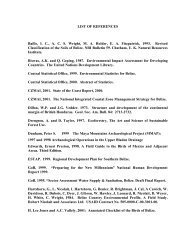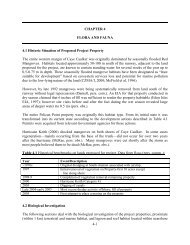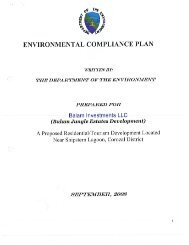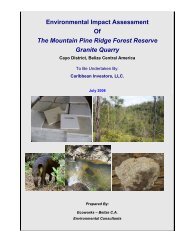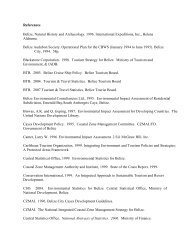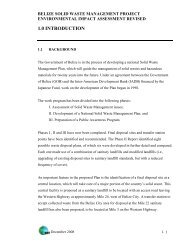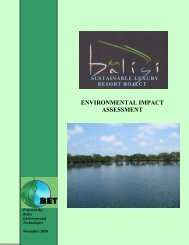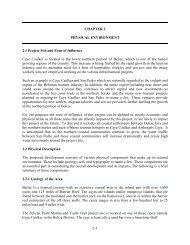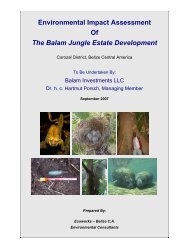- Page 1 and 2:
ENVIRONMENTAL IMPACT ASSESSMENT for
- Page 3 and 4:
2.5.1 Regional Geology 2-73 2.5.2 S
- Page 5 and 6:
7.6 Waste Category III and IV - Ind
- Page 7 and 8:
10.4.4.3 Road Access 10-12 10.4.4.5
- Page 9 and 10:
List of Figures No. Title Sec./Pg.
- Page 11 and 12:
Table 10.1 ABR EIA Matrix 10-3 Tabl
- Page 13 and 14:
Fecal: of or related to feces. Flor
- Page 15 and 16:
Tide: periodic rise and fall of the
- Page 17 and 18:
ORIENTATION NOTES The current EIA s
- Page 19 and 20:
The resort facilities include: (i)
- Page 21 and 22:
Table 2: Caye Occupancy Type Descri
- Page 23 and 24:
impacts of note are the dredging an
- Page 25 and 26:
1.0 Project Description 1.1 Project
- Page 27 and 28:
PL 1.1 PL 1.1: North/South view of
- Page 29 and 30:
Fig. 1.2: Conceptual Development Pl
- Page 31 and 32:
Components No. of Units/ Lots No. o
- Page 33 and 34:
Fig. 1.2b: Elevation Contours in re
- Page 35 and 36:
Fig. 1.3a: Phase I of Development 1
- Page 37 and 38:
Fig. 1.4: Development Components at
- Page 39 and 40:
Fig. 1.5b: On-Site Project Roads an
- Page 41 and 42:
Fig. 1.7a: Over-water Buildings, Pi
- Page 43 and 44:
1.2.3.1 Construction Phase Most of
- Page 45 and 46:
The utilities to be located in the
- Page 47 and 48:
1.4 Staffing The total staffing for
- Page 49 and 50:
Fig. 2.1: Ecosystems Map of Propose
- Page 51 and 52:
waves, which forms an extensive zon
- Page 53 and 54:
Table 2.1: Water Quality Tests Resu
- Page 55 and 56:
2.2.6 Salinity The proposed project
- Page 57 and 58:
least diverse and numerically limit
- Page 59 and 60:
These included the seagrass Halodul
- Page 61 and 62:
Table 2.2A: Terrestrial and Inter-t
- Page 63 and 64:
Common Name and/or Local Name Scien
- Page 65 and 66:
Common Name and/or Local Name Scien
- Page 67 and 68:
Common Name and/or Local Name Scien
- Page 69 and 70:
Common Name Scientific Name Obs. Tu
- Page 71 and 72:
Common Name Scientific Name Obs. Tu
- Page 73 and 74:
Table 2.2B: Sub-tidal plants of the
- Page 75 and 76:
Common Name Scientific Name Obs. Tu
- Page 77 and 78:
PL 2.5 PL 2.6 PL 2.5: Eastern appro
- Page 79 and 80:
PL 2.13 PL 2.14 PL 2.13: Manatee Gr
- Page 81 and 82:
PL 2.21 PL 2.22 PL 2.21: Stakes or
- Page 83 and 84:
Table 2.3: Invertebrates including
- Page 85 and 86:
Common Name or Local Name Scientifi
- Page 87 and 88:
Common Name or Local Name Beaded Se
- Page 89 and 90:
Common Name or Local Name M u stard
- Page 91 and 92:
PL 2.23 PL 2.24 PL 2.23: Horse Conc
- Page 93 and 94:
Table 2.4: Fish Species Found in Pr
- Page 95 and 96:
Common Name Scientific Name Obs. Tu
- Page 97 and 98:
Common Name Scientific Name Obs. Tu
- Page 99 and 100:
Common Name Scientific Name Obs. Tu
- Page 101 and 102:
Common Name Scientific Name Obs. Tu
- Page 103 and 104:
Table 2.5 Reptiles and Amphibians C
- Page 105 and 106:
(Sphaerodactylus glaucus) [See Tabl
- Page 107 and 108:
Common Name Scientific Name Obs. Tu
- Page 109 and 110:
Table 2.7: Birds Found in and Aroun
- Page 111 and 112:
Common Name Scientific Name Obs. Tu
- Page 113 and 114:
Common Name Scientific Name Obs. Tu
- Page 115 and 116:
Common Name Scientific Name Obs. Tu
- Page 117 and 118:
The CITES listing of the Hawks Bill
- Page 119 and 120:
Fig. 2.4: BCNP/MR Zoning Scheme 2-7
- Page 121 and 122:
2.5.3 Geomorphology The beaches of
- Page 123 and 124:
3.0 Policy Review 3.1 INTRODUCTION
- Page 125 and 126:
3.1.3 Coastal Zone Management Strat
- Page 127 and 128:
3.1.10 Belize Public Health Act Rev
- Page 129 and 130:
(7) Each traps shall be monitored e
- Page 131 and 132:
(e) No person shall disturb the nat
- Page 133 and 134:
The import into, transit through or
- Page 135 and 136:
3.1.28 International Conventions an
- Page 137 and 138:
4.0 WATER RESOURCES 4.1 Occupancy C
- Page 139 and 140:
4.4 Selection of the preferred sour
- Page 141 and 142:
schedule. Nevertheless, it is expec
- Page 143 and 144:
Table 4.5 Rainfall Volume collected
- Page 145 and 146:
Fig 4.2 Water Harvesting Layout for
- Page 147 and 148:
Fig. 4.4 Typical Brine Injection We
- Page 149 and 150:
ANALYZER ANALYZER INPUT CONTROLLER
- Page 151 and 152:
This will include the determination
- Page 153 and 154:
Table 4.8 ABR Surface water and wel
- Page 155 and 156:
5.0 Wastewater Disposal 5.1 Nature
- Page 157 and 158:
5.4 Environmental Wastewater Load C
- Page 159 and 160:
2. Prefabricated Secondary Treatmen
- Page 161 and 162:
Fig. 5.1 Proposed Project Sewer Tre
- Page 163 and 164:
6.0 ENERGY GENERATION 6.1 Energy De
- Page 165 and 166:
for energy generation are compared
- Page 167 and 168:
Fig. 6.1 Above Ground Storage Tank
- Page 169 and 170:
7.0 SOLID WASTE 7.1 Solid Waste Cat
- Page 171 and 172:
According to the BSWMP (Stantec 199
- Page 173 and 174: natural lighting. The trees cleared
- Page 175 and 176: the landfill when ready. Used batte
- Page 177 and 178: Table 7.4b Waste Reduction Yield fo
- Page 179 and 180: 8.2 Hurricane Preparedness Plan (Ev
- Page 181 and 182: - At least two tarpaulins for damag
- Page 183 and 184: 8.2.7 Safety Precautions These prec
- Page 185 and 186: 1) Fire alarm detection and notific
- Page 187 and 188: Table 8.3 Inland Spill Level Level
- Page 189 and 190: 9.0 Integrated Social Assessment Re
- Page 191 and 192: some 1.3 miles south west of the NO
- Page 193 and 194: populations not found on the island
- Page 195 and 196: 9.3 Land Tenure In the early 1990s
- Page 197 and 198: Fig. 9.2 Reef Cuts In the Region of
- Page 199 and 200: Depth in a small lagoon that leads
- Page 201 and 202: each ridge where it meets the mangr
- Page 203 and 204: Fig. 9.5 Dive Sites at Ambergris Ca
- Page 205 and 206: 9.7.4 The San Pedro Town Council Th
- Page 207 and 208: 9.10 Cayes Development Policy and t
- Page 209 and 210: 9.14.1 Bacalar Chico National Park
- Page 211 and 212: Fig. 9.6 Bacalar Chico National Par
- Page 213 and 214: zone are to prevent fishery stocks
- Page 215 and 216: 9.14.3 Rocky Point The entire beach
- Page 217 and 218: The system's seven sites illustrate
- Page 219 and 220: Chapter 10 10.0 Environmental Impac
- Page 221 and 222: energy generation, the production o
- Page 223: system 0.8 - 3 Miles North and Sout
- Page 227 and 228: There are no secondary impacts of n
- Page 229 and 230: Road Access Disturbances (noise, a
- Page 231 and 232: Noise pollution from equipment and
- Page 233 and 234: 10.4.4.8 Education/Health Services
- Page 235 and 236: Category of Project Activity Existi
- Page 237 and 238: - Demand for services - Impacts on
- Page 239 and 240: 11.0 Impact Mitigation Chapter 11 1
- Page 241 and 242: Development Activity Primary Impact
- Page 243 and 244: to allow for the re-colonization of
- Page 245 and 246: Development Activity Primary Impact
- Page 247 and 248: Table 11.3: Mitigation Matrix in Re
- Page 249 and 250: use conflicts is the issue of touri
- Page 251 and 252: Development Activity General Social
- Page 253 and 254: Development Activity General Social
- Page 255 and 256: Table 12.1: Proposed Monitoring Pla
- Page 257 and 258: Parameter Frequency Critical Level
- Page 259 and 260: Parameter Frequency Critical Level
- Page 261 and 262: Parameter Frequency Critical Level
- Page 263 and 264: Development Issue Option #1 & Justi
- Page 265 and 266: Development Issue Option #1 & Justi
- Page 267 and 268: Development Issue Option #1 & Justi
- Page 269 and 270: Development Issue Option #1 & Justi
- Page 271 and 272: References Auil, N. 1997. Manatee R
- Page 273 and 274: Littler, D.S., M.M. Littler and B.L
- Page 275 and 276:
Thurman, H.V. 1988. Introductory Oc
- Page 277 and 278:
TABLE OF CONTENTS Introduction…
- Page 279 and 280:
ancient Maya, particularly from Lat
- Page 281 and 282:
Figure 1: Map of Belize showing loc
- Page 283 and 284:
Fig. 3: Map of Ambergris Caye showi
- Page 285 and 286:
Fig. 4: Map of Ambergris Caye showi
- Page 287 and 288:
assessment. If we are accurate, how
- Page 289 and 290:
Fig. 7: Section Plan of posthole te
- Page 291 and 292:
should therefore be taken into care
- Page 293 and 294:
Franco The Franco site is located a
- Page 295 and 296:
REFERENCES CITED Boxt, Matthew 1983
- Page 297 and 298:
McKillop, Heather 1980 Moho Caye, B
- Page 299 and 300:
. Photo 1: View of Rocky Point Phot
- Page 301 and 302:
Photos 5—8: Various views of tran
- Page 303 and 304:
Photo 11 & 12: Photograph of Unit 1
- Page 305 and 306:
Photo 15: Photograph of potsherds r
- Page 307 and 308:
Goldsmith F.B. 1991. Monitoring for
- Page 309 and 310:
Paz, G.M. and T. Grimshaw. 2001. St




